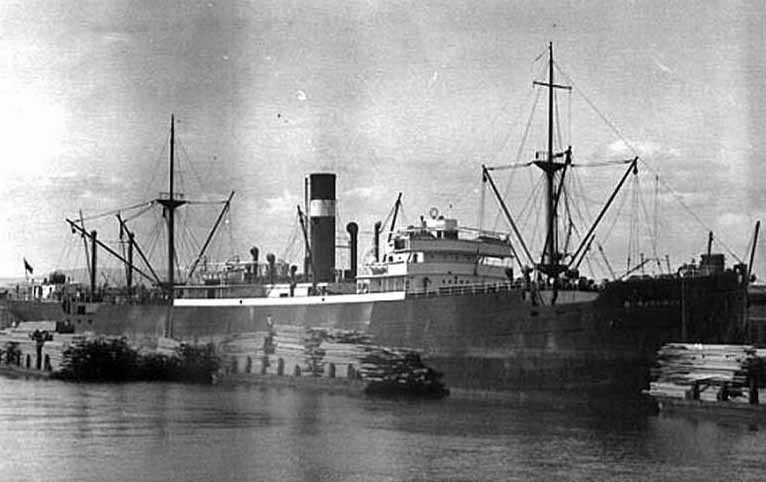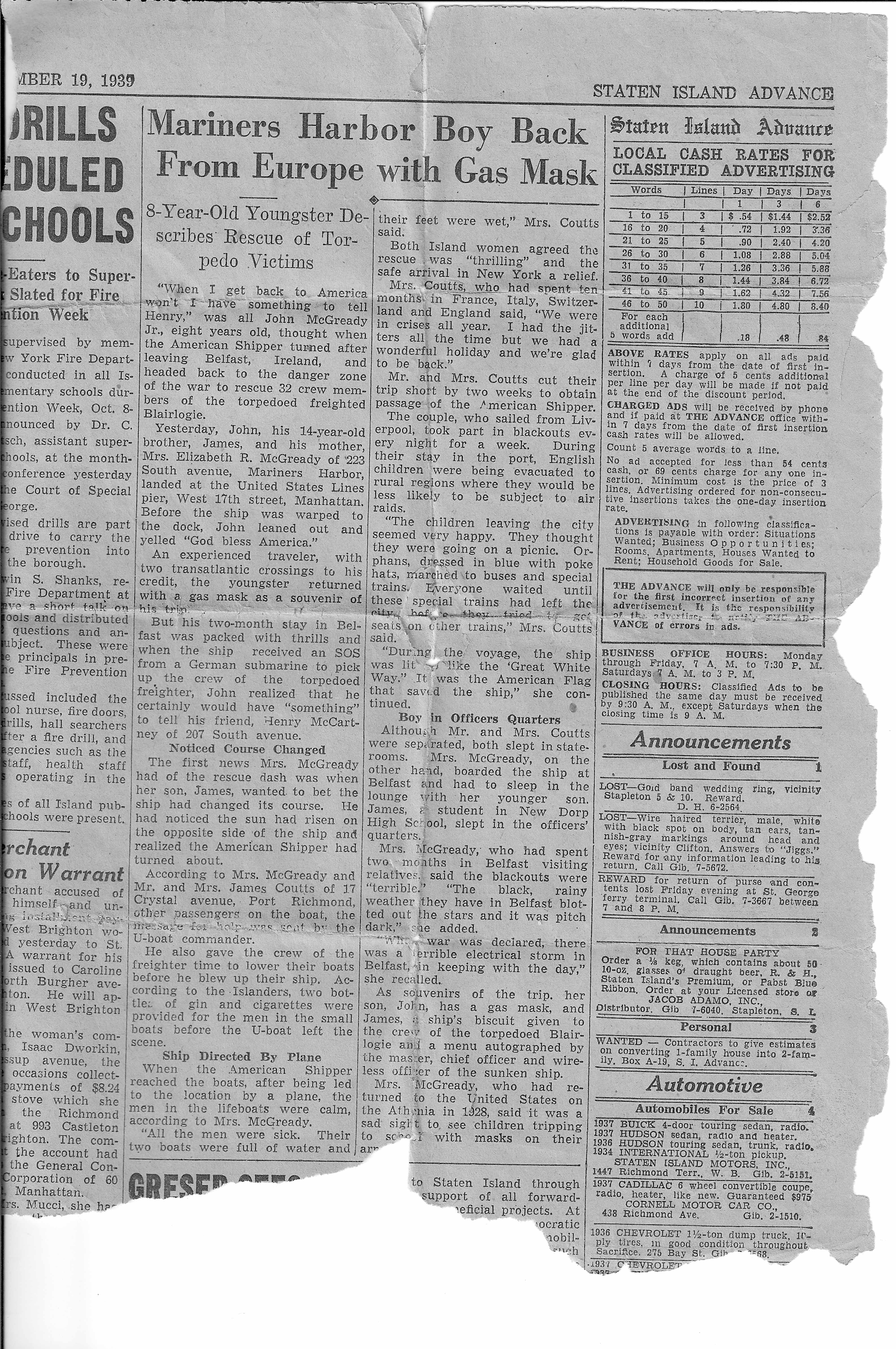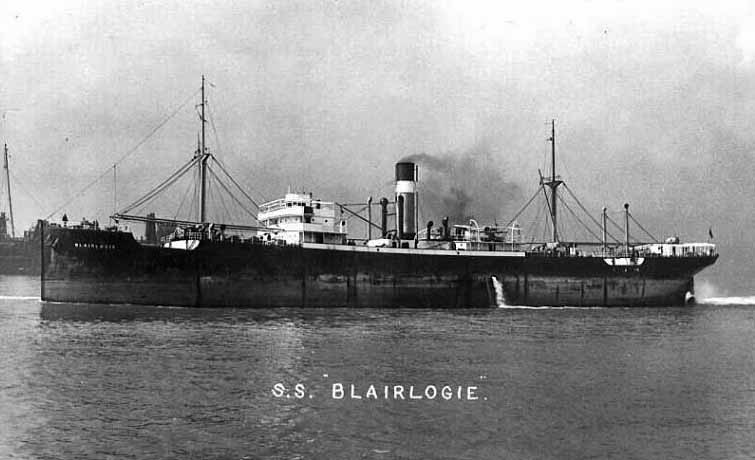SS Blairlogie
 |
The German U Boat U-30 had been at sea for several days,
under strict orders to avoid contact or discovery. On September 3rd
1939 she received notification that Germany was now at war with Great Britain. The U boat’s commander
was Lieutenant Fritz-Julius Lemp. He had been in command for almost a year,
therefore was not unaware of the “rules”. On the evening of September 3rd,
the
Athenia
was sighted by the U-30 about
250 miles northwest of Inishtrahull, Northern Ireland. The U boat sank her and
the rest, as they say is history. Athenia has her own page here but, we now
follow the U-30 as she ran away from the Athenia.
It was September 11th 1939 when the U-30 surfaced and
warned the ship to take to the lifeboats before she (U-30) would open fire.
According to witnesses - according to Mrs McGready and Mr and Mrs James Coutts
and other passengers on the boat, it was the U Boat that radioed for assistance
for the Blairlogie. He let the crew lower the boats and gave the men in the
boats 2 bottles of gin and some cigarettes before the submarine left the scene. The SS American Shipper (US Lines) had left Belfast and was already clear of the immediate area when news of the U-30's torpedoing of the Blairlogie came through. Passenger John McGready jnr, aged 8, noticed that the sun had risen of the opposite side of the ship the next morning. American Shipper was heading back towards the Blairlogie. They picked up 32 survivors from some very wet lifeboats. |
| Here then is the newspaper report from September 19th 1939. This is, of necessity, a large file, so may take some time to open if your computer is on a slow speed access. An interesting point is the American descriptions of life in Liverpool and Belfast "blackouts were terrible, the black rainy weather they have in Belfast blotting out the stars and it was pitch dark" and "took part in blackouts every night for a week" in Liverpool. I have reprinted the text below to save time reading the account. |
 |
The reprinted text is below Mariners Harbor Boy Back From Europe With Gas Mask 8 year old Youngster describes Rescue of Torpedo Victims
“When I get back to America will I have something to
tell Henry,” was all John McGready Jr., eight years old, thought when the
American Shipper turned after leaving Belfast, Ireland, and headed back to the
danger zone of the war to rescue 32 crew members of the torpedoed freighter
Blairlogie. Yesterday, John, his 14-year-old brother, James, and his mother,
Mrs. Elizabeth R. McGready of 223 South avenue, Mariners Harbor, landed at the
United States Lines pier, West 17th street, Manhattan. Before the ship was
warped to the dock, John leaned out and yelled “God bless America.” An
experienced traveler, with two transatlantic crossings to his credit, the
youngster returned with a gas mask as a souvenir of his trip. But his two-month
stay in Belfast vas packed with thrills and when the ship received an SOS from a
German submarine to pick up the crew of the torpedoed freighter, John realized
that lie certainly would have “something” to tell his friend, Henry McCartney of
207 South Avenue.
The first news Mrs. McGready had of the rescue dash was when her son, James, wanted to bet the ship had changed its course. He had noticed the sun had risen on the opposite side of the ship and realized the American Shipper had turned about. According to Mrs. McGready and Mr. and Mrs. James Coutts of 17 Crystal Avenue, Port Richmond, other passengers on the boat, the message for help was sent by the U-boat commander. He also gave the crew of the freighter time to lower their boats before he blew up theit ship. According to the Islanders, two bottles of gin and cigarettes were provided for the men in the small boats before the U-boat left the scene.
Ship Directed By Plane
When the American Shipper reached the boats, after being led to the location by a plane, the men in the lifeboats were calm, according to Mrs. McGready, “All the men were sick. Their two boats were full of water and and their feet were wet,” Mrs. Coutts said. Both Island women agreed the rescue - was “thrilling” and the safe arrival in New York a relief. Mrs. Coutts, who had spent ten months in France, Italy, Switzer land and England said, “We were in crises all year, I had the jitters all the time but we had a wonderful holiday and we’re glad to be back.” Mr. and Mrs. Coutts cut their trip short by two weeks to obtain passage of the American Shipper. The couple, who sailed from Liverpool, took part in blackouts every night for a week. During their stay in the port, English children were being evacuated to rural regions where they would be less likely to be subject to air raids. “The children leaving the city seemed very happy. They thought they were going on a picnic. Orphans, dressed in blue with poke hats, marched to buses and special trains. Everybody waited until these special trains had left the city, before they tried to get seats on other trains Mrs. Coutts said. “During the voyage, the ship was lit up like the ‘Great White Way.” It was the American Flag that saved the ship,” she continued.
Although Mr. and Mrs. Coutts were seperated, both slept
in state rooms. Mrs. McGready, on the other hand, boarded the ship at Belfast
and had to sleep in the lounge with her younger son. James, a student in New
Dorp High School, slept in the officers’ quarters. Mrs McGready, who had spent
two months in Belfast visiting relatives said the blackouts were “terrible’.
“The black, rainy weather they have in Belfast blotted out the stars and it was
pitch dark,” she added. When war was declared, there was a terrible electrical
storm in Belfast, in keeping with the day,” she recalled. As souvenirs of the
trip, her son, John, has a gas mask, and James, a ship’s biscuit given to the
crew of the torpedoed Blairlogie and a menu autographed by the master, chief
officer and wireless operator of the sunken ship. |
 |
| James McGready, who supplied me with the newspaper article writes: I was 14. My brother, John, was 8. As I recall, the American Shipper had been modified to provide accommodations for additional passengers. They had an area where bunks were installed to be used for female passengers. The ladies did not object to an 8 year old boy but did not want to have a 14 year old. The ladies won out and I was put with the crew. The picture of the ship (below) is not familiar. I don't remember the loading booms. My "wager" with my mother rewarded me with a deck chair for the remainder of the voyage. I do remember the Blairlogie crew coming on board on a ladder over the port side just forward of the superstructure. They were then taken up to the next level (which we call the O1 Level in the US Navy) . It could be that all that rigging on the main deck was behind me as I watched but I just don't remember. I do remember that the deck chairs were on the O1 or O2 level, starboard side. I am led to believe that the vessel below is the ship the boys sailed to America on. |
|
SS American Shipper later Ville de Mons
|